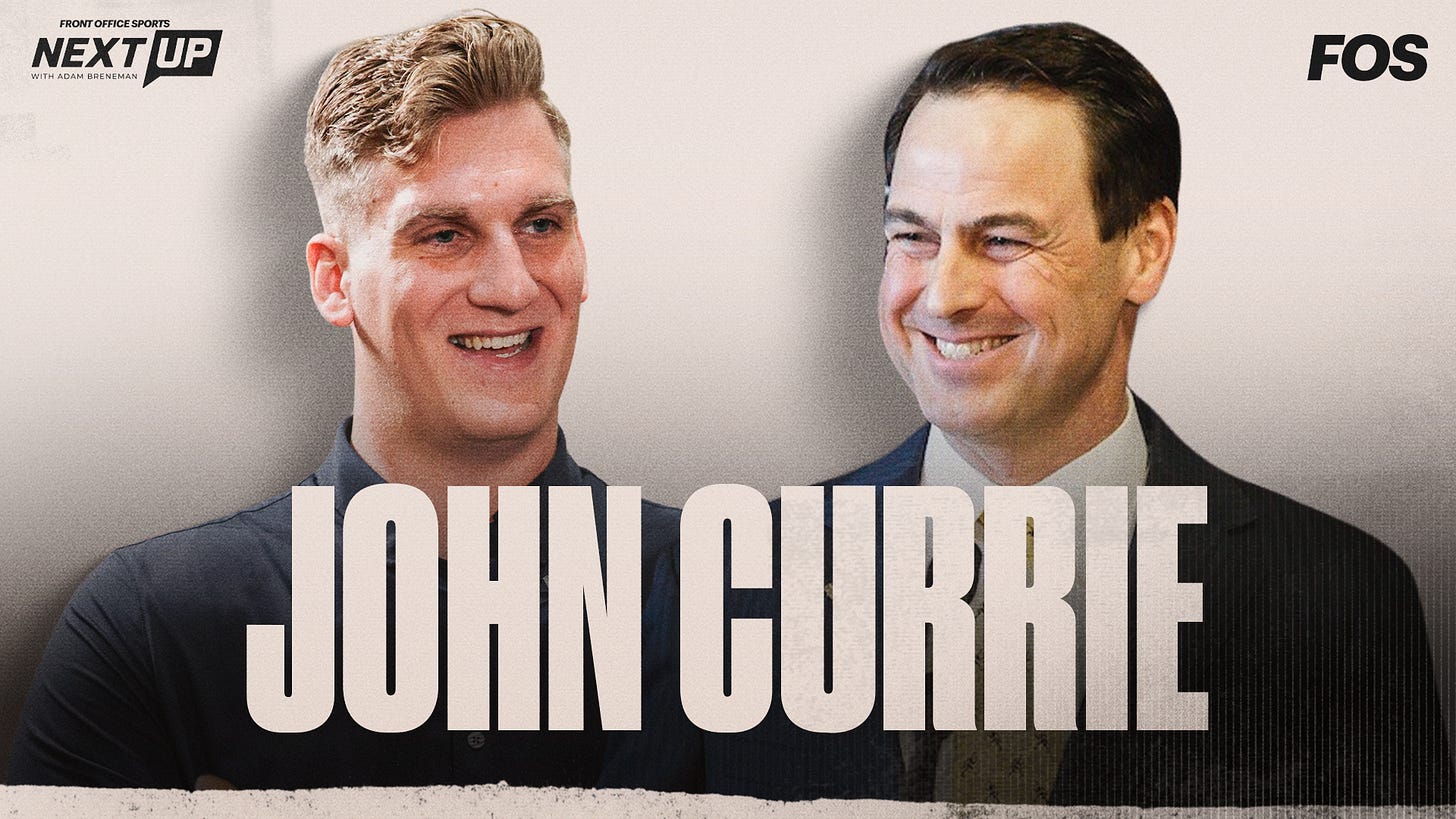Wake Forest AD John Currie Opens Up About NIL, Revenue Sharing, & The ACC's Future
“There’s a new $20 million a year expense if you want to be in this club and win,” Currie told me.
Welcome to Breneman Journal by Adam Breneman — a 2x per-week newsletter with analysis, hot takes, and news on all things college football, NIL, and recruiting. Subscribe now and join nearly 13,000 other sports fans, and share this newsletter with all the college football fans you know!
Hey friends,
My “Next Up” Podcast tour recently took me into the heart of ACC country, where I sat down with Wake Forest Athletic Director John Currie.
The seasoned Power Four athletic director joined me for candid insight into the future of college sports, rapid changes in NIL and revenue sharing, and how Wake Forest is positioning itself for long-term success.
During our 40-minute conversation, Currie dove into the new realities of being an athletic director at a high-profile institution, how he approaches hiring coaches, and why he’s bullish on the ACC’s future as a conference.
Before hopping into the episode, let’s look at my three favorite takeaways from my discussion with Currie.
1️⃣ Adapt To Ever-Evolving Change
The model of combining higher education with big-time collegiate athletics has changed more than ever within the last two decades, but Currie’s affinity for Wake Forest hasn’t wavered since he graduated from the university in 1993.
Currie boasts 15 years of Power Five athletic director experience, but he first began his administrative career as an assistant AD under his mentor, Ron Wellman.
Currie met Wellman as a student, where he participated as a member of Wake Forest’s student government. From there, Wellman took him under his wing.
“I followed my mentor, Ron Wellman, who was the AD here for 27 years, and we actually had a joint press conference,” Currie told me. “It was really about his retirement, and then ‘Ok, this guy’s next,’” he joked. “I was kind of the assistant to the president for a month and a half, which was like the best job I’ve ever had…”
Aside from beginning his career in Winston-Salem, Currie also accumulated stops at Kansas State and Tennessee, working in both the Big 12 and SEC.
While the current landscape of college athletics is nearly upside-down compared to when he started at Kansas State in 2009, he told me the changes are almost “cyclical” in nature.
“Some of the stuff that’s happening is cyclical. It’s happened before,” Currie said. “I’m like, ‘Oh, yeah, that’s what happened at K-State in 2011, right?’ Then there’s other things that come up, and there’s a rule that everybody’s concerned about, and now, I’m the old guy. And I say, ‘Well you know what happened is, back in 1994…’ and people look at me like I’m 123 years old.”
Before the 2012 football season, the Big 12 underwent a massive wave of conference realignment, as Texas A&M and Missouri left the conference, leaving vacancies for TCU and West Virginia. The year prior, the conference shrunk to 10 teams after the departures of Colorado (Pac-12) and Nebraska (Big Ten).
With change and age comes experience, and that’s exactly what Currie took away from Wellman’s mentorship as a successful administrator.
This newsletter is presented by... PrizePicks
PrizePicks is the easiest way to play daily fantasy. Getting started is very simple — register for an account, make a deposit, and pick more or less on 2-6 player stats to win payouts of up to 25x!
This season, place a $5 lineup, and use code “AdamB” to instantly earn $50 in bonus bets. Click on the link below to get started today!
2️⃣ Embrace The Higher Mission
Wake Forest prides itself on being a “full-service university,” emphasizing the mission of providing a world-class education in parallel with championship athletics.
Currie embraces this mission and prides himself and Wake Forest on being a member of the ACC, which he calls the “best collection of the highest-rated institutions in the country other than the Ivy League.”
When attracting student-athletes to Winston-Salem, Currie and his administration couple Wake Forest’s academic structure and rigor with championship athletics to sell their prestigious brand.
“People who are choosing Wake Forest are choosing Wake Forest because we’re academically rigorous, but they’re also choosing it because it’s intimate,” Currie explained. “They’re in small classes, they know their professors, they do research, it’s a beautiful setting, and then, we have big-time sports.”
At Wake Forest, the modern student-athlete can achieve all of his or her aspirations, Currie explained.
In total, Wake Forest has won 10 NCAA team national championships, paired with an additional 10 individual championships. In football, specifically, Currie knows his program’s trajectory is sky-high under newly hired head coach Jake Dickert from Washington State.
“We’re winning national championships and ACC championships,” Currie said. “We’re playing for the ACC football championship just four years ago, [and] we’re on ESPN, the ACC Network. That’s a big part of it.”
🔥 New FREE Resources for Athletes
The #1 question I get asked in my DMs is:
“How do aspiring college athletes get noticed by college coaches or scouts?”
So, I just launched a new video training called the Get Coaches to Call Gameplan.
Inside I reveal ALL the secrets that top recruits use to get noticed at the elite D1 programs!
Any athlete, parent, or coach can use this to get ahead of the competition.
3️⃣ Lean On Creativity
Last November, the prospect of revenue sharing across college sports became a reality, which is set to begin during the 2025 academic year.
The NCAA set a revenue sharing cap of $20.5 million per school, allowing athletic departments to compensate athletes and allocate “budgets” per each athletic program or team.
“There’s a new $20 million a year expense if you want to be in this club and win,” Currie told me, candidly. “… If you want to be in that university-brand club, it costs $20 million a year — and it’ll cost more next year than it did this year.”
Currie is far from naive to this new reality, but he sees Wake Forest’s situation as advantageous in comparison to rival institutions.
“One of our advantages at Wake Forest is our scale,” Currie said. “… We have 13 programs [and] 18 sports because six of our sports are men’s and women’s indoor-outdoor cross-country [or] track and field… Unlike some of my colleagues who have 25 head coaches that they have to work through this with, we have 13 and we can consolidate resources and be transparent with all of our people.”
Aside from revenue-sharing alone, Currie and his counterparts have remained intuitive on how to best garner donor-driven momentum for NIL monetization.
Wake Forest’s NIL initiatives function on a “sports-specific fundraising model,” giving coaches the ability to sell their program and generate investments from top fans without having donations split among other teams.
“Someone that really loves women’s soccer, let’s let them invest in women’s soccer,” Currie said, as an example. “They don’t want to give to football, [so] let them invest in women’s soccer. And guess what? The closer they are to it, the more they give.”
Currie mentioned transparency has been key in creating trust between his team and the Demon Deacons’ faithful fanbase.
“With trust comes investment, and with investment can come success.”
To watch my full conversation with Currie, click here.
If you have any questions, comments, or feedback, please don’t hesitate to reach out to me by email at adam@brenemanmedia.com.
You can also find me on Twitter, Instagram, TikTok, LinkedIn or Facebook.
Shoutout to Connor Krause for helping to write this newsletter and putting it together!
Interested in advertising with Breneman Journal? Email me.









